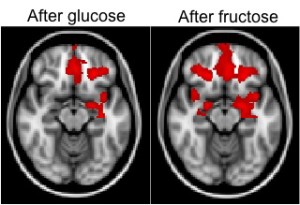The American diet is loaded with sugar. Sugar is added to foods and drinks to make them taste better, and we often seek out sweet foods because they are pleasurable to eat. Our group is interested in understanding how sugar affects brain reward pathways and the motivation to eat.
In our latest study, published in the Proceedings of the National Academy of Sciences (PNAS), we set out to explore how the brain and body respond to two types of sugar: fructose and glucose. Glucose is used to fuel all of the cells in our body, including our brain. Fructose, however, is mainly metabolized in the liver and fails to stimulate hormones, like insulin, that are important in helping us feel full.
What we did
We studied 24 healthy young men and women who came in for brain scans in the mid-morning before they ate breakfast. On one occasion they consumed a drink sweetened with glucose and on another day they consumed a drink sweetened with fructose. We performed brain scans while the volunteers looked at pictures of tasty foods (like pizza) or objects (like a lamp) and rated their hunger and desire for food. We also sampled their blood for hormones that help control appetite. This allowed us to see how consuming fructose compared to glucose affected brain, hormone and hunger responses.
Next, we wanted to see how motivated people were to eat high-calorie foods after consuming fructose or glucose. We gave the volunteers choices between being served tasty food immediately after the study or having money sent to them one month later. The amount of money was titrated up or down during these trials depending on their responses, and one of the trials was randomly selected so that they either received the food item immediately after the scan or the money one month later.

Results
Our results suggest that consuming fructose relative to glucose activates brain reward regions and may promote feeding behavior. When volunteers consumed the fructose drink (compared to when they consumed the glucose drink), it led to greater activity in brain reward areas, including the orbitofrontal cortex. Moreover, fructose consumption correlated with greater ratings of hunger and desire for food, as well as a greater willingness to give up long-term money rewards to obtain immediate high-calorie foods.
What it all means
It’s important to put these results into context. While fructose is found naturally in fruit and vegetables, these wholesome foods are loaded with other important nutrients, including fiber, which slows the absorption of sugar and helps you feel full. So, should you stop eating fruit? No—the amount of fructose found in whole fruits and vegetables is low compared to the amount of fructose found in sugar-sweetened foods and beverages. The best way to reduce fructose intake is to decrease the consumption of added sugar sweeteners, which are the main source of fructose in the American diet.
How much sugar is too much?
The American Heart Association recommends that most American women consume no more than 100 calories per day, or about 6 teaspoons of sugar. For men, they recommend less than 150 calories per day, or about 9 teaspoons of sugar.
Similarly, the World Health Organization recommends consuming less than 10% of total daily calories as free sugars, and suggests a further reduction to less than 5% of total calories.
How do you reduce added sugars from your diet?
-Check out the label. A good rule of thumb: the closer to the beginning of the ingredient list sugar appears, the higher the sugar content of that food is. Not surprisingly, many processed baked goods, such as cookies and brownies, are high in added sugar. However, sugar sweeteners are also hidden in a number of “healthy” foods, like yogurt, granola bars, cereals, salad dressing, and ketchup. So, it’s always good idea to check the labels on foods and drinks.
-Decrease the consumption of sugar-sweetened beverages, such as soft drinks. The average 12-ounce soft drink contains about 8 teaspoons, of added sugar (about half of which is fructose). Replace soda and juice with water or low-fat milk.
-Limit foods and drinks that contain more than 10 grams of sugar per 100 gram serving size. Try to eat a variety of whole fruits and vegetables, and include more fiber-rich whole grains, lentils, nuts, lean meats, fish, and plain yogurts (without the added sugar).
-Swap out white bread for whole wheat breads; add berries, bananas or dried fruit to oatmeal or cereal; snack on air-popped popcorn, almonds, or string cheese.
Want to read more? Check out some media coverage of our study:
“Fructose may increase cravings to high-calorie foods” – The New York Times
“Fructose may motivate people to seek out food” – Scientific American
“This kind of sugar triggers unhealthy cravings” – Time Magazine
Sources:
Differential effects of fructose versus glucose on brain and appetitive responses to food cues and decisions for food rewards (PNAS, Luo et al. 2015)
(Dietary Sugars Intake and Cardiovascular Health: A Scientific Statement From the American Heart Association Circulation. 2009; 120:1011-1020) http://www.heart.org/HEARTORG/GettingHealthy/NutritionCenter/HealthyEating/Added-Sugars_UCM_305858_Article.jsp
http://who.int/nutrition/publications/guidelines/sugars_intake/en/
